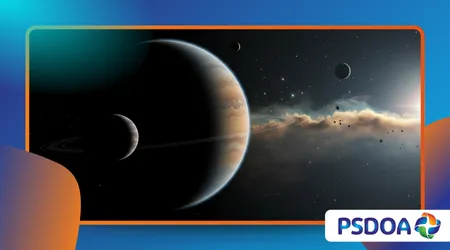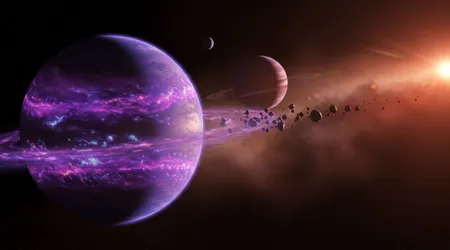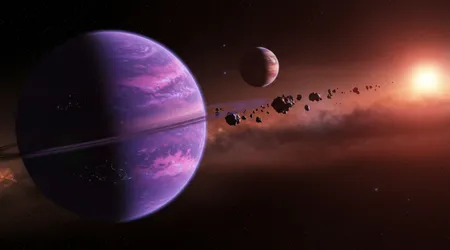Exoplanetas extraños con atmósferas extrañas

Exoplanetas extraños cautivan a los astrónomos como ninguna otra cosa, sus atmósferas se arremolinan con secretos que desafían nuestra comprensión de la formación planetaria.
Anuncios
Imagínese mundos en los que la lluvia cae en forma de fragmentos de vidrio o vapores que transportan metales disueltos, en reinos muy alejados de los apacibles cielos azules de la Tierra.
Al alcanzar el hito de 6000 exoplanetas confirmados en septiembre de 2025, según el Archivo de Exoplanetas de la NASA, estas rarezas nos recuerdan la inmensidad y la variedad del cosmos. Llevan los telescopios al límite y suscitan debates sobre el significado actual de "habitable".
Descubrimientos recientes, como el KMT-2023-BLG-1896L b, con masa similar a Neptuno, anunciado hace apenas unos días, resaltan este aumento: más de 100 nuevos hallazgos solo este año.
Sin embargo, es el exoplanetas extraños Con atmósferas de ciencia ficción que roban protagonismo. ¿Por qué se forman estos entornos? ¿Podrían albergar vida en formas que aún desconocemos?
Anuncios
Este artículo profundiza en el tema y sostiene que estudiarlos no es sólo una trivialidad: es la clave para desbloquear la línea de montaje del universo.
Exploramos infiernos ardientes, velos nebulosos, enigmas acuáticos y el panorama general de la astrobiología. Cada revelación construye un argumento: estos mundos no son anomalías; son pistas sobre cómo evolucionan los planetas bajo una presión estelar extrema. Abróchate el cinturón, tu visión del espacio cambiará.
Mundos Infernales: Donde las atmósferas hierven y se vaporizan
KELT-9b arde a 4300 Kelvin, más caliente que algunas estrellas, y su atmósfera de hidrógeno se desvanece bajo la incesante radiación. Metales como el hierro se vaporizan aquí, creando una mezcla nebulosa que dispersa la luz en patrones irregulares.
Los astrónomos detectaron nubes de óxido de titanio en este gigante gaseoso utilizando telescopios terrestres en 2018, pero los datos del Hubble de 2025 refinaron la imagen del ciclo de vapores como una forja cósmica. extraño exoplaneta ejemplifica la furia del bloqueo de marea, un lado eternamente horneado.
Imaginen la lluvia de titanio condensándose en el lado nocturno, para luego sublimarse de nuevo al amanecer. Esta dinámica justifica replantear los modelos de migración planetaria; estos Júpiter calientes no se formaron en el mismo lugar, sino que se desplazaron en espiral hacia el interior, arrastrando sus mantos volátiles.
HD 189733b, a 64 años luz de distancia, desata tormentas de vidrio laterales a partir de partículas de silicato azotadas por vientos de 8.000 km/h. Los espectros del Telescopio Espacial James Webb, a principios de 2025, confirmaron estas gotitas, que evocan una licuadora de arena fundida.
Este mundo de tonos azules, que orbita cada 2,2 días, pierde masa en relación con su estrella, formando una cola similar a la de un cometa. Esto nos desafía: ¿cómo soportan las atmósferas tal erosión? Los vientos estelares activos las esculpen, de forma similar a como los ríos esculpen los cañones en la Tierra.
++ Entrelazamiento cuántico: la “acción espeluznante” que Einstein odiaba
WASP-12b devora su propia envoltura, mientras el monóxido de carbono domina una neblina hinchada que se expande debido a la desintegración orbital. Recientes observaciones de seguimiento del Spitzer en 2025 fijan su temperatura en 2800 Kelvin, con trazas de metano que sugieren un desequilibrio químico.
Estos procesos alimentan el argumento de que existe una juventud caótica en los sistemas planetarios. exoplanetas extraños Este tipo de colisiones sugieren que las primeras inyectaron gases exóticos, alterando la composición para siempre. Debemos investigar más a fondo para rastrear esos orígenes.
Consideremos HAT-P-7b, donde las nubes de óxido de aluminio reflejan la luz como espejos, detectado mediante espectroscopia de transmisión el año pasado. Su estratosfera brilla de forma inusualmente intensa, un faro en los estudios infrarrojos.
Esta configuración plantea una pregunta retórica: si las nubes pudieran blindar un planeta contra su sol, ¿no redefiniría eso los entornos "hostiles"? Dichas protecciones podrían resguardar los océanos subterráneos en zonas más frías.

Curiosidades nubladas: Brumas que oscurecen y encantan
GJ 1214b se envuelve en una densa neblina de vapor de agua, un "mundo de vapor" a 48 años luz de distancia, donde la presión aplasta las moléculas formando hielos exóticos. La revisión del Hubble en 2025 descartó cielos despejados, favoreciendo la presencia de una capa contaminada por la desgasificación volcánica.
Las señales de transmisión se atenúan aquí, imitando un banco de niebla perpetua. extraño exoplaneta Argumenta en contra de los modelos oceánicos simples: el calor interno de la formación probablemente impulsa la evaporación continua, manteniendo el velo.
Amplíe WASP-17b, una superboca hinchada con una atmósfera tan difusa que rivaliza con la del poliestireno expandido en densidad, con hidrógeno y helio extendidos en un vasto radio. Las observaciones terrestres de 2024, respaldadas por los datos de TESS de este año, revelan tasas de escape 100 veces superiores a las de la Tierra.
Lea también: Cómo se comunican las plantas a través de redes fúngicas subterráneas
La baja gravedad permite que los gases se dispersen con facilidad, creando un brillo similar al del algodón de azúcar en el ultravioleta. Esto refuerza la hipótesis de que existen "núcleos fallidos" en gigantes gaseosos que se formaron planetas y que se acrecionaron con demasiada debilidad, dejando capas etéreas.
Compárelo con un globo de animal en una feria cósmica: inflado pero frágil, listo para estallar bajo los empujones estelares. Estos nebulosos... exoplanetas extraños Enséñanos el papel de la fragilidad en la diversidad; sin ella, veríamos mundos uniformes.
Kepler-51d flota como un globo, con su envoltura 200 veces menos densa que el agua, impregnada de neblinas fotoquímicas causadas por el bombardeo de rayos ultravioleta. Un estudio publicado en 2025 en Nature Astronomy detalló la disociación del metano, que da origen a cadenas de carbono que atenúan la luz estelar.
Este mini-Neptuno, orbitando una enana roja, ejemplifica el lado salvaje de la fotoquímica: las moléculas se rompen y se reestructuran en la fragua de la luz solar. Esto insta a realizar estudios más exhaustivos de estrellas de baja masa, donde prosperan estas rarezas.
Leer más: La ciencia del ferrofluido: líquido que reacciona a los imanes
Adéntrese en LHS 1140 b, una supertierra rocosa con aire potencialmente rico en nitrógeno, pero los silicatos nebulosos de los impactos nublan la vista. Los espectros del JWST de mediados de 2025 insinuaron trazas de amoníaco, lo que desató debates sobre los ciclos del nitrógeno más allá de la Tierra.
Estas obstrucciones frustran la obtención de imágenes directas, pero exigen paciencia en la búsqueda de exoplanetas: las neblinas evolucionan, revelando capas con el tiempo. La paciencia merece la pena, ya que los atisbos más claros prometen la búsqueda de biofirmas.
Maravillas acuáticas: océanos de vapor y misterio
Pasemos a K2-106 b, un mundo "clave" con un núcleo de hierro que se asoma a través de una fina capa de vapor, a 200 años luz de distancia. Los datos de velocidad radial de HARPS en 2025 revelaron este híbrido, donde el agua se evapora al espacio.
Su atmósfera se aferra tenuemente, una mezcla de hidrógeno y vapor de H₂O de una superficie bombardeada. Esto extraño exoplaneta postula una formación híbrida: acumulación rocosa seguida de captura volátil, desafiando las clasificaciones binarias.
Imagine columnas de vapor que estallan como géiseres con esteroides, alimentando una neblina global. Esta volatilidad refuerza los argumentos a favor de mundos transitorios habitables que coquetean con la humedad antes de que el calor estelar los domine.
TOI-1452 b, un candidato a supertierra para albergar océanos profundos, muestra señales de agua en su espectro de transmisión, según un informe de ESO de 2025. Nubes de silicato de magnesio se superponen a las envolturas de hidrógeno, lo que sugiere mantos hidratados.
Esta joya de 100 años luz orbita una enana roja de forma estable, evitando las erupciones que despojan de aire. Desafía los prejuicios de los planetas secos; el aporte de agua a través de cometas probablemente esculpió estas capas, lo que impulsa modelos centrados en cometas.
Pensemos en un ejemplo original: supongamos que sondas extraterrestres sobrevuelan las nubes de TOI-1452 b y toman muestras de gotitas mezcladas con sales disueltas que recuerdan la sopa primigenia de la Tierra, pero sobrecalentada a 400 Kelvin.
Estos reinos de vapor encienden debates sobre la persistencia del agua líquida; las presiones podrían comprimir fluidos supercríticos, dando origen a vida en ollas a presión que apenas imaginamos.
LTT 1445 A b se empareja con planetas hermanos en un sistema multimundial, cuya atmósfera posiblemente esté cargada de cristales de hielo de agua provenientes de trampas frías. Los mapas infrarrojos de Spitzer de 2025 revelaron ciclos de escarcha, característicos de las configuraciones con bloqueo de mareas.
Un hemisferio se congela mientras el otro se descongela, impulsando vientos que redistribuyen el vapor. Esto extraño exoplaneta ejemplifica microclimas a escala planetaria, abogando por una habitabilidad zonificada sobre biosferas uniformes.
Otro giro original: imagine tapetes microbianos prosperando en la zona crepuscular de LTT 1445 A b, aprovechando los gradientes químicos del patio de juego de la evolución de los cambios de hielo y vapor en un crepúsculo perpetuo.
Este tipo de configuraciones exigen que repensemos los nichos de la vida; no en todas partes, sino en los bordes donde los extremos se equilibran.
| Nombre del exoplaneta | Distancia (años luz) | Característica atmosférica clave | Temperatura de equilibrio (K) |
|---|---|---|---|
| KELT-9b | 670 | vapores de óxido de titanio | 4,300 |
| HD 189733b | 64 | Lluvia de silicato (vidrio) | 1,200 |
| 55 Cáncer e | 41 | Neblina de diamante rica en carbono | 2,400 |
| GJ 1214b | 48 | Espesa neblina de vapor de agua | 500 |
| WASP-17b | 1,300 | Envolvente H/He de baja densidad | 1,100 |
Esta tabla destaca cinco ejemplos, extraídos del catálogo 2025 de la NASA, que subrayan los extremos térmicos que generan cielos extraños.
Implicaciones cósmicas: reescribiendo las reglas para la vida extraterrestre
Más de 6.000 exoplanetas catalogados significan que 1 de cada 5 estrellas alberga al menos uno, una estadística de la actualización de Gaia de 2025 que revoluciona las visiones aislacionistas. Estos exoplanetas extraños No son rarezas; son la norma que da forma a los censos galácticos.
Sus atmósferas, analizadas por el NIRSpec de tipo prisma del JWST, revelan desequilibrios que indican geología o biología activa. Los ciclos de silicato en la tectónica de placas especulares de HD 189733b sugieren gemelos geodinámicos.
Argumenten esto: si la lluvia de vidrio erosiona las superficies como el ácido, ¿podría concentrar minerales para la química prebiótica? Los extremófilos de la Tierra prosperan en manantiales de sílice; amplíen la escala.
La influencia del carbono en WASP-12b evoca escenarios supervenusianos, donde los velos de CO2 descontrolados esterilizan mundos. Sin embargo, podrían persistir refugios subterráneos, protegidos por el empuje rocoso para conceptos de perforación y sondaje en futuras misiones.
Estos conocimientos impulsan un cambio de paradigma: espectros de habitabilidad, no binarios. Exoplanetas extraños Al igual que los baños de vapor de GJ 1214b, sugieren que el conjunto de herramientas de la vida incluye vapor como solvente, no solo líquido.
Reflexionemos sobre 55 Cancri e, conocido como el "mundo diamante" por su abundancia de carbono, cuya exosfera nebulosa podría sembrar partículas orgánicas en el espacio cercano. Un artículo de Madhusudhan et al. publicado en 2024 en la revista Astrophysical Journal modeló esta volatilidad y predijo señales detectables de carbono.
Tales eyecciones podrían fertilizar protoplanetas, lo que sugiere el papel de la química interestelar en los orígenes. Lo pasamos por alto bajo nuestra propia responsabilidad.
Ejemplo original: imaginemos un explorador en un análogo enfriado, que tamiza grano de diamante en busca de volátiles atrapados y desbloquea historias de migración grabadas en redes cristalinas.
Otra: una nave espacial que roza la onda de choque de KELT-9b y prueba iones metálicos para mapear las interacciones de los vientos estelares: datos valiosos para proteger nuestra propia magnetosfera.
Estos exoplanetas extraños Exigen acciones interdisciplinarias: químicos descifrando neblinas, modeladores simulando lluvias. ¿El resultado? Planos para la ingeniería de hábitats resilientes.
Finalmente, nos hacen comprender qué biosferas ocultas se esconden en las nieblas de titanio. Buscar respuestas redefine la huella cósmica de la humanidad.

Envolviendo lo extraño: Hacia un horizonte más extraño
Sumergirse en estas rarezas atmosféricas revela un universo que insiste en sorprender. Desde vientos cristalinos hasta océanos de vapor, exoplanetas extraños Desmantelar nuestras lentes geocéntricas e instar a teorías más audaces.
Hemos catalogado extremos que susurran potenciales inexplotados: vida en la neblina, quizás, o mundos que se autoesculpen bajo el asedio estelar. El archivo, con 6000 elementos, crece semanalmente; cada entrada es un hilo en el tapiz.
Sin embargo, la urgencia nos atenaza: la vida útil del JWST se acerca a su fin, y telescopios de nueva generación como el Observatorio de Mundos Habitables están a años de distancia. Actúe ahora o perderá la oportunidad de ver estos enigmas.
Esta exploración aboga por el giro de la financiación, priorizando lo extraño para iluminar lo banal. Al fin y al cabo, la normalidad surge del estudio de lo marginal.
Agradecido por herramientas como el archivo de la NASA, que democratizan estas maravillas. Comparte tu opinión: ¿cuál? extraño exoplaneta ¿Qué despierta más tu imaginación? El cosmos espera nuestra próxima mirada.
Para concluir, estos mundos no son curiosidades lejanas; son espejos que reflejan posibilidades que debemos perseguir. ¡Brindemos por el próximo descubrimiento que lo trastoque todo!
Preguntas frecuentes
¿Qué hace que la atmósfera de un exoplaneta sea “extraña”?
Extraño significa composiciones o dinámicas alejadas de las normas del sistema solar, como vapores de metales o precipitaciones de vidrio, impulsadas por órbitas cercanas o químicas únicas.
¿Cómo estudiamos estas atmósferas distantes?
Mediante espectroscopia de tránsito: la luz se filtra a través de la atmósfera, revelando huellas de gas con telescopios como el JWST.
¿Podría existir vida en mundos tan extremos?
Posiblemente en nichos protegidos, como capas subterráneas protegidas de la radiación, pensemos en extremófilos a escala alienígena.
¿Cuál es el último y extraño hallazgo de un exoplaneta?
A partir de septiembre de 2025, KMT-2023-BLG-1896L b se destaca por su masa similar a la de Neptuno en un evento de microlente, lo que sugiere envolturas brumosas.
